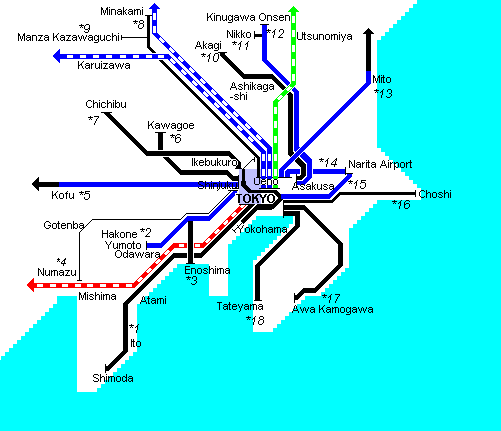|
This is the center of modern Japanese economy, politics and culture. Being most densely populated area in Japan, public transport is fairly convenient. Considering that traffic is always heavy and unconfortable in Kanto area, it is usually better to take trains in moving around. Not only JR but also some private railways provide Limited Express services. Note that Japan Rail Pass and Seishun 18 kippu is not valid to private railways. This map includes those services, but not many other local services. For long distant Shinkansen or Limited Express, see Central Honshu Map. To Hakone Odakyu Limited Express services called 'Romance Car' go from Shinjuku to Hakone Yumoto, which is the entrance of Hakone Region. From Hakone Yumoto, Hakone Tozan Railways go up to Gora, then changing funicular and cable cars you reach Lake Asinoko, center of Hakone. You can also go Hakone by JR services from Tokyo or Yokohama to Odawara. There are bus service to Hakone from Odawara. It is not so far and you do not have to take Limited Express trains. Both JR and Odakyu provides frequent local services which are sometimes crowded but cheaper. To Izu Peninsula Shinkansen 'Kodama' goes Atami (entrance of Eastern Izu area) and Mishima (Western Izu) two services per hour. Atami is not so far from Tokyo and also accessed by frequent local trains. Limited Express 'Odoriko' goes conventional line and direct to Ito and Shimoda, tourist center of Eastern Izu. To Western Izu, Limited Express 'Asagiri' from Shinjuku (Odakyu Railways) to Numazu is another option. To Nikko The most common way is to take Tobu Railways Limited Express 'Kegon' from Asakusa, accessed by Eidan subway Ginza Line from central Tokyo, about 20 minutes. Also take Limited Express 'Kinu' to Kinugawa Onsen, which is more frequent, and there is a connecting services from Shimo Imaichi on the way to Nikko. If you have Japan Rail Pass which is not valid to Tobu Railways, you take Tohoku Shinkansen to Utsunomiya then change to local trains for Nikko. |

|

|
|
*1 Super View Odoriko, Odoriko (Tokyo - Shimoda) operated by JR *2 Hakone (Shinjuku- Hakone Yumoto) Support (Shinjuku- Odawara) operated by Odakyu Railways *3 Enoshima (Shinjuku- Katase Enoshima) operated by Odakyu Railways *4 Asagiri (Shinjuku- Numazu) operated by Odakyu Railways and JR *5 Super Azusa, Azusa (Tokyo Shinjuku- Matsumoto/ Minami Otari) Kaiji (Tokyo Shinjuku- Kofu) operated by JR *6 Koedo (Seibu Shinjuku- Hon Kawagoe) operated by Seibu Railways *7 Chichibu (Ikebukuro- Seibu Chichibu) operated by Seibu Railways *8 Minakami (Tokyo Ueno- Minakami) operated by JR *9 Kusatsu (Tokyo Ueno- Manza Kazawaguchi) operated by JR |
|
*10 Ryomo (Asakusa- Akagi) operated by Tobu Railways *11 Kegon (Asakusa- Tobu Nikko) operated by Tobu Railways *12 Kinu (Asakusa- Kinugawa Onsen) operated by Tobu Railways *13 Super Hitachi, Fresh Hitachi (Tokyo Ueno- Mito/ Takahagi/ Iwaki /Sendai) operated by JR *14 Sky Liner (Keisei Ueno - Narita Airport) operated by Keisei Railways *15 Narita Express (Tokyo Shinjuku/ Yokohama - Narita Airport) operated by JR *16 Shiosai (Tokyo - Choshi) operated by JR *17 Wakashio (Tokyo- Awa Kamogawa) operated by JR *18 Sazanami (Tokyo- Tateyama) operated by JR |
BACK HOME